Unifying Flood-Risk Communication: Empowering Community Leaders Through AI-Enhanced, Contextualized Storytelling
Abstract
1. Introduction
2. Problem Definition
2.1. Devastating Impact of Floods
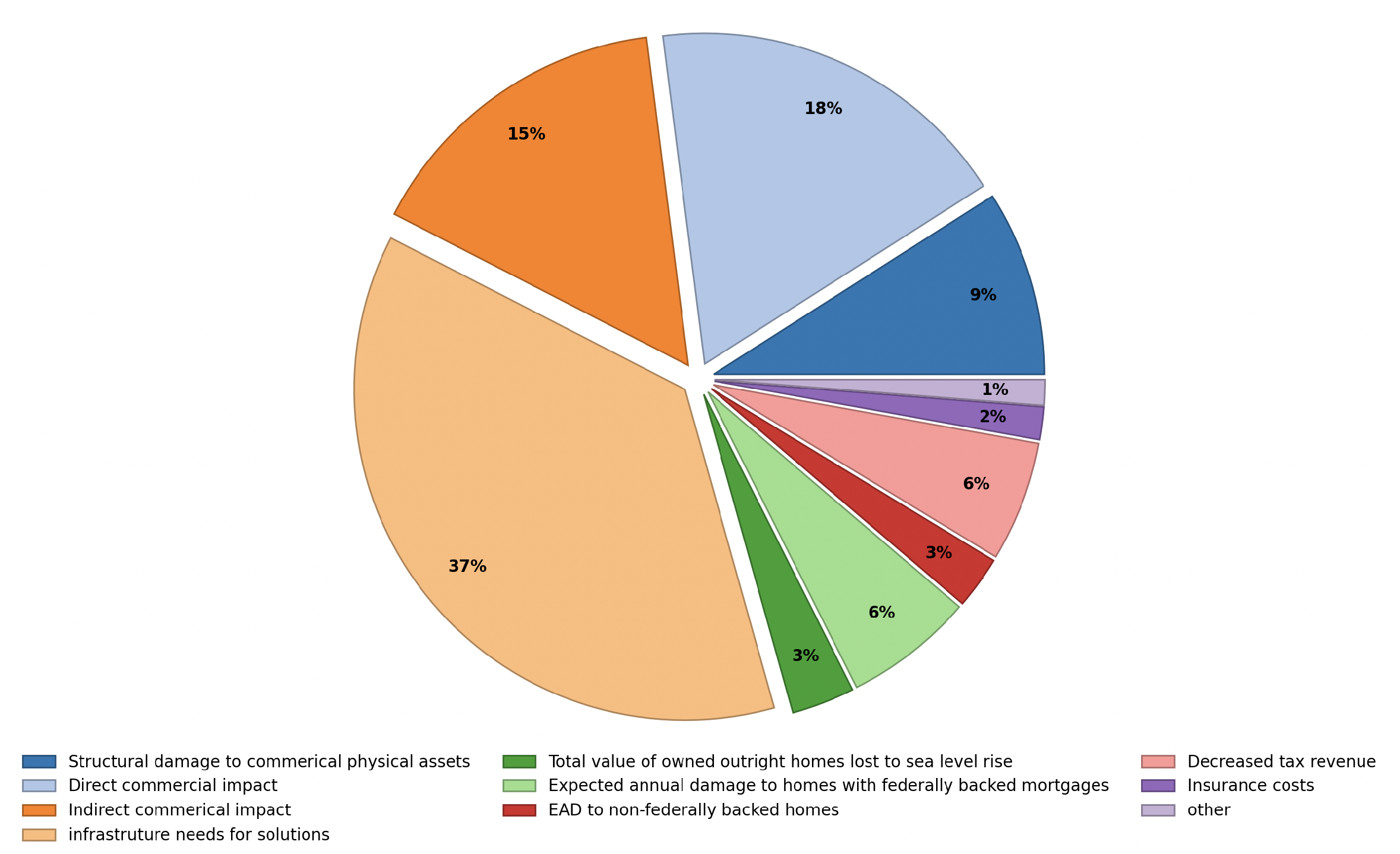
2.2. Information Overload and Data Silos
| Type | References | Links |
|---|---|---|
| Map | [35,36] | www.harriscountyfws.org/, ifis.iowafloodcenter.org/ifis/ |
| Information | [37,38,39,40] | yaleclimateconnections.org/, www.facebook.com/, www.tiktok.com/en/, www.redcross.org/get-help/how-to-prepare-for-emergencies/types-of-emergencies/flood.html |
| TV | [41,42] | www.foxweather.com/, www.weathernationtv.com/ |
| Website | [35,36,40,43,44,45] | www.harriscountyfws.org/, ifis.iowafloodcenter.org/ifis/, yaleclimateconnections.org/, www.accuweather.com/, weather.com/, spacecityweather.com/ |
| Alert | N/A | National Alert Systems are managed by Government organizations |
| Radar | [22,35,36] | www.harriscountyfws.org/, ifis.iowafloodcenter.org/ifis/, www.wunderground.com/ |
| Meteorologist | [46,47,48,49,50] | x.com/JimCantore, x.com/spann, www.currentlyhq.com/p/july-28-2024, x.com/GingerZee, cliffmass.blogspot.com/ |
| Data | [51,52] | firststreet.org/methodology/flood, climatecheck.com/ |
| Risk | [40,51,52] | yaleclimateconnections.org/, firststreet.org/methodology/flood, www.climatecheck.com/ |

2.3. Limitations of Current Toolkits
3. Resilience Begins with Community Leaders
3.1. Key Stakeholder Groups (Community Leaders, NOAA/NWS)
3.2. How Can Community Leaders Save Lives?
4. Storytelling as a Risk-Communication Strategy
4.1. The Power of Storytelling in Driving Action
4.2. Examples of Storytelling Channels and Mediums
4.3. The Imperative of Contextualization in Storytelling
4.4. Example of Current Risk-Communication Storytelling
5. Technological Opportunities
5.1. Opportunity for Tailored, Trusted Communication
5.2. Leveraging LLMs for Contextual Storytelling
5.3. Knowledge Graphs for Marrying Information Silos
5.4. RAG for Generating Contextually Grounded Stories
6. Proposed Platform: AI for Unified Flood Communication
6.1. Guiding Principles
“To design an AI-enabled platform that centralizes fragmented flood-risk data and automatically generates context-specific narratives and visuals (stories), thereby reducing community leaders’ time synthesizing whilst improving the clarity and timeliness of public flood-risk communication.”
“The task of category systems is to provide maximum information with the least cognitive effort” [109]
“One purpose of categorization is to reduce the infinite differences among stimuli to behaviorally and cognitively usable proportions.” [109]
- The ontology provides an efficient map of flood-risk concepts;
- The knowledge graph links real-world data to that map, enabling reasoning;
- RAG-driven storytelling delivers timely, audience-specific flood communication
6.2. Intended Users
6.3. Ontology and Knowledge-Graph Construction
6.4. AI Services
6.5. Comparison to Existing Tools
7. Discussion and Implications
7.1. Benefits
7.2. Broader Impact
8. Conclusions
9. Future Work
Author Contributions
Funding
Data Availability Statement
Acknowledgments
Conflicts of Interest
Abbreviations
| AI | Artificial Intelligence |
| CDC | Centers for Disease Control and Prevention |
| FEMA | Federal Emergency Management Agency |
| FEWS | Flood Early Warning Systems |
| FLAI | Flood Language AI |
| GAO | Government Accountability Office |
| GPT | Generative Pre-trained Transformer |
| KG | Knowledge Graph |
| LLM | Large Language Model |
| MLLM | Multimodal Large Language Model |
| NIFC | National Interagency Fire Center |
| NOAA | National Oceanic and Atmospheric Administration |
| NLP | Natural Language Processing |
| NWS | National Weather Service |
| OFPO | Ontology for Flood Process Observation |
| POLARISCO | Operational Platform for Interagency Civil Security Intelligence Updating |
| RAG | Retrieval-Augmented Generation |
| SOSA | Sensor, Observation, Sample, and Actuator Ontology |
| SQL | Structured Query Language |
| SSN | Semantic Sensor Network Ontology |
| USGS | United States Geological Survey |
References
- Rentschler, J.; Salhab, M.; Jafino, B.A. Flood Exposure and Poverty in 188 Countries. Nat. Commun. 2022, 13, 3527. [Google Scholar] [CrossRef]
- Kirezci, E.; Young, I.R.; Ranasinghe, R.; Lincke, D.; Hinkel, J. Global-Scale Analysis of Socioeconomic Impacts of Coastal Flooding over the 21st Century. Front. Mar. Sci. 2023, 9, 1024111. [Google Scholar] [CrossRef]
- United Nations Office for Disaster Risk Reduction. Global Assessment Report on Disaster Risk Reduction 2022: Our World at Risk: Transforming Governance for a Resilient Future; United Nations Office for Disaster Risk Reduction: Geneva, Switzerland, 2022. [Google Scholar]
- Kaya, Y. Automated Estimation of Building Heights with ICESat-2 and GEDI LiDAR Altimeter and Building Footprints: The Case of New York City and Los Angeles. Buildings 2024, 14, 3571. [Google Scholar] [CrossRef]
- Dietrich, J.T.; Magruder, L.A.; Holwill, M. Monitoring Coastal Waves with ICESat-2. J. Mar. Sci. Eng. 2023, 11, 2082. [Google Scholar] [CrossRef]
- Wiley, K.; Adams, C. Flash Flooding Claimed More Than 100 Lives in Central Texas. Here’s What We Know About the Victims. KXAN. 2025. Available online: https://www.kxan.com/central-texas/2025-central-texas-hill-country-flash-flooding-victims/ (accessed on 22 July 2025).
- Koch, A. Deadly Texas Flood Exposes Neglected Infrastructure. Yahoo News. Available online: https://www.yahoo.com/news/deadly-texas-flood-exposes-neglected-232505520.html (accessed on 22 July 2025).
- Hernandez, J. How Good Was the Forecast? Texas Officials and the National Weather Service Disagree. NPR. Available online: https://www.npr.org/2025/07/06/nx-s1-5458512/texas-flash-flood-weather-forecast (accessed on 22 July 2025).
- Arnold, M.; Goldschmitt, M.; Rigotti, T. Dealing with information overload: A comprehensive review. Front. Psychol. 2023, 14, 1122200. [Google Scholar] [CrossRef] [PubMed]
- Fang, N.Z.; Bedient, P.B.; Brody, S.; Zaretsky, M.; Li, D.D.; Li, W.; Greenwood, K.; Furrh, T. Flood Early Warning Systems (FEWS) Guidance Document for Texas; Texas Water Development Board Contract No. 2101792481 Final Report, Received 10 February 2023; Texas Water Development Board (TWDB): Austin, TX, USA, 2023. [Google Scholar]
- Fansher, M.; Walls, L.; Hao, C.; Subramonyam, H.; Boduroglu, A.; Shah, P.; Witt, J.K. Narrative visualizations: Depicting accumulating risks and increasing trust in data. Cogn. Res. Princ. Implic. 2025, 10, 7. [Google Scholar] [CrossRef] [PubMed]
- Sermet, Y.; Demir, I. Towards an information centric flood ontology for information management and communication. Earth Sci. Inform. 2019, 12, 541–551. [Google Scholar] [CrossRef]
- Zhu, R.; Shimizu, C.; Stephen, S.; Fisher, C.K.; Thelen, T.; Currier, K.; Janowicz, K.; Hitzler, P.; Schildhauer, M.; Li, W.; et al. The KnowWhereGraph: A Large-Scale Geo-Knowledge Graph for Interdisciplinary Knowledge Discovery and Geo-Enrichment. arXiv 2025, arXiv:2502.13874. [Google Scholar]
- Staff, J.E.C.D. Flooding Costs the U.S. Between $179.8 and $496.0 Billion Each Year. United States Joint Economic Committee. 2024. Available online: https://www.jec.senate.gov/public/index.cfm/democrats/2024/6/flooding-costs-the-u-s-between-179-8-and-496-0-billion-each-year (accessed on 9 June 2025).
- National Weather Service. Official Website. Available online: https://www.weather.gov (accessed on 9 June 2025).
- National Weather Service. Historic July 26th–July 30th, 2022 Eastern Kentucky Flooding. Available online: https://www.weather.gov/jkl/July2022Flooding (accessed on 9 June 2025).
- Tompkins, F.; Watts, B. Flooding Is Nearly a Daily Occurrence Throughout the U.S. The Pew Charitable Trusts—U.S. Conservation. 15 December 2022. Available online: https://www.pew.org/en/research-and-analysis/articles/2022/12/15/flooding-is-nearly-a-daily-occurrence-throughout-the-us (accessed on 25 June 2025).
- Stanke, C.; Murray, V.; Amlôt, R.; Nurse, J.; Williams, R. The effects of flooding on mental health: Outcomes and recommendations from a review of the literature. PLoS Curr. 2012, 4, e4f9f1fa9c3cae. [Google Scholar] [CrossRef]
- Chinguwo, D.D.; Deus, D. Assessment of community-based flood early warning system in Malawi. Jàmbá J. Disaster Risk Stud. 2022, 14, 1166. [Google Scholar] [CrossRef]
- Li, C.; Wang, H.; Wu, J.; Li, N. Impacts of Urbanization on Flooding: A Bibliometric Analysis Based on CiteSpace. Nat. Hazards 2020, 104, 1945–1972. [Google Scholar] [CrossRef]
- Mostafiz, R.B.; Rohli, R.V.; Friedland, C.J.; Lee, Y. Actionable Information in Flood Risk Communications and the Potential for New Web-Based Tools for Long-Term Planning for Individuals and Community. Front. Earth Sci. 2022, 10, 840250. [Google Scholar] [CrossRef]
- Weather Underground. Homepage. Available online: https://www.wunderground.com/ (accessed on 17 June 2025).
- U.S. Geological Survey. Flood Inundation Mapping (FIM) Program. Available online: https://www.usgs.gov/mission-areas/water-resources/science/flood-inundation-mapping-fim-program (accessed on 17 June 2025).
- California Department of Water Resources. California Data Exchange Center (CDEC). Available online: https://cdec.water.ca.gov/ (accessed on 17 June 2025).
- National Flood Insurance Program. FloodSmart.gov Homepage. Available online: https://www.floodsmart.gov/ (accessed on 17 June 2025).
- National Severe Storms Laboratory. Severe Weather 101—Floods. Available online: https://www.nssl.noaa.gov/education/svrwx101/floods/ (accessed on 17 June 2025).
- Federal Emergency Management Agency. Floods. Ready.gov. Available online: https://www.ready.gov/floods (accessed on 17 June 2025).
- National Oceanic and Atmospheric Administration. NOAA Weather Radio. Available online: https://www.weather.gov/nwr/ (accessed on 17 June 2025).
- Federal Communications Commission. Emergency Alert System (EAS). Available online: https://www.fcc.gov/emergency-alert-system (accessed on 17 June 2025).
- Federal Emergency Management Agency. FEMA Flood Map Service Center. Available online: https://msc.fema.gov/portal/home (accessed on 17 June 2025).
- National Weather Service. Wireless Emergency Alerts (WEA) Information. Available online: https://www.weather.gov/riw/WEA_Info (accessed on 17 June 2025).
- Federal Emergency Management Agency. Integrated Public Alert and Warning System (IPAWS). Available online: https://www.fema.gov/emergency-managers/practitioners/integrated-public-alert-warning-system (accessed on 17 June 2025).
- National Oceanic and Atmospheric Administration. Sea Level Rise Viewer. Available online: https://coast.noaa.gov/slr/ (accessed on 17 June 2025).
- NOAA National Centers for Environmental Information. Storm Events Database. Available online: https://www.ncdc.noaa.gov/stormevents/ (accessed on 17 June 2025).
- Harris County Flood Warning System. Homepage. Available online: https://www.harriscountyfws.org/ (accessed on 17 June 2025).
- Iowa Flood Center. Iowa Flood Information System (IFIS). Available online: https://ifis.iowafloodcenter.org/ifis/ (accessed on 17 June 2025).
- American Red Cross. Flood Safety. Available online: https://www.redcross.org/get-help/how-to-prepare-for-emergencies/types-of-emergencies/flood.html (accessed on 17 June 2025).
- Meta. Facebook Homepage. Available online: https://www.facebook.com/ (accessed on 17 June 2025).
- TikTok Inc. TikTok Homepage. Available online: https://www.tiktok.com/en/ (accessed on 17 June 2025).
- Yale Center for Environmental Communication. Yale Climate Connections. Available online: https://yaleclimateconnections.org/ (accessed on 17 June 2025).
- Fox News Media. Fox Weather Homepage. Available online: https://www.foxweather.com/ (accessed on 17 June 2025).
- WeatherNation TV. Homepage. Available online: https://www.weathernationtv.com/ (accessed on 17 June 2025).
- Space City Weather. Houston Weather Blog. Available online: https://spacecityweather.com/ (accessed on 17 June 2025).
- The Weather Company. Weather.com Homepage. Available online: https://weather.com/ (accessed on 17 June 2025).
- AccuWeather Inc. Homepage. Available online: https://www.accuweather.com/ (accessed on 17 June 2025).
- Spann, J. Personal X (Formerly Twitter) Page. Available online: https://x.com/spann?lang=en (accessed on 17 June 2025).
- Holthaus, E. July 28, 2024 Update. Currently. Available online: https://www.currentlyhq.com/p/july-28-2024 (accessed on 17 June 2025).
- Mass, C. Cliff Mass Weather Blog. Available online: https://cliffmass.blogspot.com/ (accessed on 17 June 2025).
- Cantore, J. Personal X (Formerly Twitter) Page. Available online: https://x.com/JimCantore (accessed on 17 June 2025).
- Zee, G. Personal X (Formerly Twitter) Page. Available online: https://x.com/Ginger_Zee (accessed on 17 June 2025).
- First Street Foundation. Flood Risk Methodology. Available online: https://firststreet.org/methodology/flood (accessed on 17 June 2025).
- ClimateCheck. Homepage. Available online: https://climatecheck.com/ (accessed on 17 June 2025).
- YouGov. How and Where Americans Get Information About the Weather. YouGov U.S. 22 May 2024. Available online: https://today.yougov.com/health/articles/45672-how-and-where-americans-get-information-weather (accessed on 25 June 2025).
- Esparza, M.; Farahmand, H.; Brody, S.; Mostafavi, A. Examining Data Imbalance in Crowdsourced Reports for Improving Flash Flood Situational Awareness. arXiv 2022, arXiv:2207.05797. [Google Scholar] [CrossRef]
- Cable News Network (CNN). Weather Homepage. Available online: https://www.cnn.com/weather (accessed on 17 June 2025).
- NBC News. Weather Homepage. Available online: https://www.nbcnews.com/weather (accessed on 17 June 2025).
- ABC News. Weather Homepage. Available online: https://abcnews.go.com/alerts/weather (accessed on 17 June 2025).
- CBS News. Weather Homepage. Available online: https://www.cbsnews.com/weather (accessed on 17 June 2025).
- Fox News. Weather Category. Available online: https://www.foxnews.com/category/weather (accessed on 17 June 2025).
- Newsmax Inc. Homepage. Available online: https://www.newsmax.com/ (accessed on 20 July 2025).
- NewsNation LLC Homepage. Available online: https://www.newsnationnow.com/ (accessed on 20 July 2025).
- Federal Emergency Management Agency. Flood Safety Social Media Toolkit. Available online: https://www.ready.gov/flood-toolkit (accessed on 9 June 2025).
- National Weather Service. Flood Infographics. Weather-Ready Nation. 2025. Available online: https://www.weather.gov/wrn/flood_infographics (accessed on 26 June 2025).
- Venhuizen, G.J.; Hut, R.; Albers, C.; Stoof, C.R.; Smeets, I. Flooded by jargon: How the interpretation of water-related terms differs between hydrology experts and the general audience. Hydrol. Earth Syst. Sci. 2019, 23, 393–403. [Google Scholar] [CrossRef]
- Traboco, L.; Pandian, H.; Nikiphorou, E.; Gupta, L. Designing Infographics: Visual Representations for Enhancing Education, Communication, and Scientific Research. J. Korean Med. Sci. 2022, 37, e214. [Google Scholar] [CrossRef]
- Atanga, R.A. The role of local community leaders in flood disaster risk management strategy making in Accra. Int. J. Disaster Risk Reduct. 2020, 43, 101358. [Google Scholar] [CrossRef]
- National Oceanic and Atmospheric Administration. NOAA by the Numbers: NOAA’s Value to the Nation. Available online: https://repository.library.noaa.gov/view/noaa/17891 (accessed on 17 June 2025).
- Shrader, J.G.; Bakkensen, L.; Lemoine, D. Fatal Errors: The Mortality Value of Accurate Weather Forecasts. Center for Economic Studies, U.S. Census Bureau. 2023. Available online: https://www2.census.gov/ces/wp/2023/CES-WP-23-30.pdf (accessed on 17 June 2025).
- National Oceanic and Atmospheric Administration. NWS Unveils New Experimental Flood Inundation Maps. Available online: https://www.weather.gov/news/232609-experimental-flood-inundation-maps (accessed on 17 June 2025).
- Mechler, R.; Czajkowski, J.; Kunreuther, H.; Michel-Kerjan, E.; Botzen, W.; Keating, A.; McQuistan, C.; Cooper, N.; O’Donnell, I. aking Communities More Flood Resilient: The Role of Cost-Benefit Analysis and Other Decision-Support Tools in Disaster Risk Reduction. Zurich Flood Resilience Alliance. 2014. Available online: https://pure.iiasa.ac.at/id/eprint/11193/ (accessed on 17 June 2025).
- Magnusson, M. Information Seeking and Sharing During a Flood. In Proceedings of the European Conference on Social Media ECSM 2014, Brighton, UK, 10–11 July 2014; Available online: https://www.researchgate.net/publication/295869397 (accessed on 17 June 2025).
- Dahlstrom, M.F. Using Narratives and Storytelling to Communicate Science with Nonexpert Audiences. Proc. Natl. Acad. Sci. USA 2014, 111, 13614–13620. [Google Scholar] [CrossRef]
- Grainger, S.; Mao, F.; Buytaert, W. Environmental Data Visualization for Non-scientific Contexts: Literature Review and Design Framework. Environ. Model. Softw. 2016, 85, 299–318. [Google Scholar] [CrossRef]
- Slovic, P.; Finucane, M.L.; Peters, E.; MacGregor, D.G. Risk as Analysis and Risk as Feelings: Some Thoughts about Affect, Reason, Risk, and Rationality. Risk Anal. 2004, 24, 311–322. [Google Scholar] [CrossRef] [PubMed]
- Terpstra, T. Emotions, Trust, and Perceived Risk: Affective and Cognitive Routes to Flood Preparedness Behavior. Risk Anal. 2011, 31, 1658–1675. [Google Scholar] [CrossRef]
- Northwest Center for Public Health Practice. Plan for Hard-to-Reach Populations. In Emergency Risk Communication (Section 3: Planning). Available online: https://www.nwcphp.org/docs/perrcolate/erc/section3/populations.html (accessed on 8 June 2025).
- Henderson, F.; Helwig, K. A Smart Guide to Flood Risk Communication. Centre of Expertise for Waters (CREW). 2022. Available online: https://www.crew.ac.uk/sites/www.crew.ac.uk/files/publication/CRW2018_04_A-Smart_Guide_to%20Flood_Risk%20Communication.pdf (accessed on 17 June 2025).
- Miller, M.D. Clouds and Clout: Understanding the Role of Social Media in a National Weather Service Forecast Office. Master’s Thesis, Texas Tech University, Lubbock, TX, USA, 2024. Available online: https://hdl.handle.net/2346/100783 (accessed on 17 June 2025).
- Yu, J.; Li, Y.; Huang, X.; Ye, X. Data Quality and Uncertainty Issues in Flood Prediction: A Systematic Review. Int. J. Digit. Earth 2024, 17, 1033–1053. [Google Scholar] [CrossRef]
- Lee, J.; Sanders, B.F. A Review of Flood Risk Management in the USA. Water 2023, 15, 947. [Google Scholar] [CrossRef]
- Ren, M.; Zhang, Z.; Zhang, J.; Mora, L. Understanding the Use of Heterogenous Data in Tackling Urban Flooding: An Integrative Literature Review. Water 2022, 14, 2160. [Google Scholar] [CrossRef]
- Wing, O.E.J.; Lehmann, J.; Bates, P.D.; Sampson, C.C.; Smith, A.M.; Neal, J.C.; Winsemius, H.C.; Kousky, C. Inequitable Patterns of US Flood Risk in the Anthropocene. Nat. Clim. Chang. 2022, 12, 156–162. [Google Scholar] [CrossRef]
- Mileti, D.S.; Sorensen, J.H. Communication of Emergency Public Warnings: A Social Science Perspective and State-of-the-Art Assessment; Report No. ORNL-6609; Oak Ridge National Laboratory: Oak Ridge, TN, USA, 1990. [Google Scholar] [CrossRef]
- Minaee, S.; Mikolov, T.; Nikzad, N.; Chenaghlu, M.; Socher, R.; Amatriain, X.; Gao, J. Large Language Models: A Survey. arXiv 2023, arXiv:2307.06435v1. [Google Scholar] [PubMed]
- Yin, S.; Fu, C.; Zhao, S.; Li, K.; Sun, X.; Xu, T.; Chen, E. A Survey on Multimodal Large Language Models. Natl. Sci. Rev. 2024, 11, nwae403. [Google Scholar] [CrossRef]
- Kuka, V. OpenAI’s New Image Generation Model: Competing with the Studios? Learn Prompting. 3 April 2025. Available online: https://learnprompting.org/blog/openai-new-image-generation-model-competes-with-studios (accessed on 19 June 2025).
- Cui, X.; Sun, Q.; Zhou, W.; Li, H. Exploring GPT-4 Vision for Text-to-Image Synthesis Evaluation. In Proceedings of the ICLR 2024, Vienna, Austria, 7–11 May 2024; Available online: https://openreview.net/forum?id=xmQoodG82a (accessed on 19 June 2025).
- OpenAI. Introducing 4o Image Generation: A Native Multimodal Model. OpenAI Blog. 25 March 2025. Available online: https://openai.com/index/introducing-4o-image-generation (accessed on 19 June 2025).
- Kung, J.Y.; Tsuyuki, R.T. Maximizing Impact with Infographics. Can. Pharm. J. 2020, 153, 208–210. [Google Scholar] [CrossRef] [PubMed]
- Ji, Z.; Lee, N.; Frieske, R.; Yu, T.; Su, D.; Xu, Y.; Ishii, E.; Bang, Y.; Chen, D.; Dai, W.; et al. Survey of Hallucination in Natural Language Generation. arXiv 2024, arXiv:2202.03629. [Google Scholar] [CrossRef]
- Lei, Z.; Dong, Y.; Li, W.; Ding, R.; Wang, Q.; Li, J. Harnessing Large Language Models for Disaster Management: A Survey. arXiv 2024, arXiv:2501.06932. [Google Scholar]
- Zhu, X.; Guo, X.; Cao, S.; Li, S.; Gong, J. StructuGraphRAG: Structured Document-Informed Knowledge Graphs for Retrieval-Augmented Generation. Proc. AAAI Symp. Ser. 2024, 4, 242–251. [Google Scholar] [CrossRef]
- Xie, Y.; Verner, D.R.; Jiang, B.; Mallick, T.; Branham, J.; Bergerson, J.D.; Alexander, M.R.; Hutchison, J.K.; Ross, R.B.; Levy, L.-A.; et al. A RAG-Based Multi-Agent LLM System for Natural Hazard Resilience and Adaptation. arXiv 2025, arXiv:2504.17200v1. [Google Scholar]
- IBM. Black Box AI. Available online: https://www.ibm.com/think/topics/black-box-ai (accessed on 17 June 2025).
- Guarino, N.; Oberle, D.; Staab, S. What Is an Ontology? In Handbook on Ontologies; Staab, S., Studer, R., Eds.; Springer: Berlin/Heidelberg, Germany, 2009; pp. 1–17. [Google Scholar]
- Uschold, M.; Grüninger, M. Ontologies: Principles, Methods and Applications. Knowl. Eng. Rev. 1996, 11, 93–136. [Google Scholar] [CrossRef]
- Noy, N.F.; McGuinness, D.L. Ontology Development 101: A Guide to Creating Your First Ontology; Technical Report KSL-01-05; Stanford Knowledge Systems Laboratory: Stanford, CA, USA, 2001. [Google Scholar]
- Bu Daher, J.; Huygue, T.; Stolf, P.; Hernandez, N. An ontology and a reasoning approach for evacuation in flood disaster response. In Proceedings of the 17th International Conference on Knowledge Management (IKCM 2022), Potsdam, Germany, 23–24 June 2022; pp. 117–131. [Google Scholar]
- Martelo, R.; Ahmadiyehyazdi, K.; Wang, R.-Q. Towards Democratized Flood Risk Management: An Advanced AI Assistant Enabled by GPT-4 for Enhanced Interpretability and Public Engagement. Available online: https://arxiv.org/abs/2403.03188 (accessed on 20 June 2025).
- Son, J.; Lim, C.-S.; Shim, H.-S.; Kang, J.-S. Development of Knowledge Graph for Data Management Related to Flooding Disasters Using Open Data. Future Internet 2021, 13, 124. [Google Scholar] [CrossRef]
- Dorasamy, M.; Raman, M.; Kaliannan, M. Knowledge management systems in support of disasters management: A two-decade review. Technol. Forecast. Soc. Chang. 2013, 80, 1834–1853. [Google Scholar] [CrossRef]
- Chen, M.; Tao, Z.; Tang, W.; Qin, T.; Yang, R.; Zhu, C. Enhancing emergency decision-making with knowledge graphs and large language models. Int. J. Disaster Risk Reduct. 2024, 113, 104804. [Google Scholar] [CrossRef]
- Khantong, S.; Sharif, M.N.A.; Mahmood, A.K. An ontology for sharing and managing information in disaster response: An illustrative case study of flood evacuation. Int. Rev. Appl. Sci. Eng. 2020, 11, 22–33. [Google Scholar] [CrossRef][Green Version]
- Elmhadhbi, L.; Karray, M.-H.; Archimède, B.; Otte, J.; Smith, B. POLARISCO: A modular ontology for semantically enhanced interoperability in operational disaster response. Information 2021, 12, 432. [Google Scholar] [CrossRef]
- Du, W.; Liu, C.; Xia, Q.; Wen, M.; Hu, Y. OFPO & KGFPO: Ontology and knowledge graph for flood process observation. Environ. Model. Softw. 2025, 185, 106317. [Google Scholar] [CrossRef]
- Lewis, P.; Perez, E.; Piktus, A.; Petroni, F.; Karpukhin, V.; Goyal, N.; Küttler, H.; Lewis, M.; Yih, W.-t.; Rocktäschel, T.; et al. Retrieval-Augmented Generation for Knowledge-Intensive NLP Tasks. arXiv 2021, arXiv:2005.11401. [Google Scholar]
- National Academies of Sciences, Engineering, and Medicine. Communicating Science Effectively: A Research Agenda; The National Academies Press: Washington, DC, USA, 2017. [Google Scholar]
- Yu, D.; Bao, R.; Ning, R.; Peng, J.; Mai, G.; Zhao, L. Spatial-RAG: Spatial Retrieval Augmented Generation for Real-World Geospatial Reasoning Questions. arXiv 2025, arXiv:2502.18470v5. [Google Scholar]
- Rosch, E. Principles of Categorization. In Cognition and Categorization; Rosch, E., Lloyd, B.B., Eds.; Lawrence Erlbaum Associates: Hillsdale, NJ, USA, 1978; pp. 27–48. [Google Scholar]
- Xu, D.; Chen, W.; Peng, W.; Zhang, C.; Xu, T.; Zhao, X.; Wu, X.; Zheng, Y.; Wang, Y.; Chen, E. Large language models for generative information extraction: A survey. Front. Comput. Sci. 2024, 18, 186357. [Google Scholar] [CrossRef]
- Dearing, J.W. Applying Diffusion of Innovation Theory to Intervention Development. Res. Soc. Work. Pract. 2009, 19, 503–518. [Google Scholar] [CrossRef] [PubMed]
- Compton, M.; Barnaghi, P.; Bermudez, L.; García-Castro, R.; Corcho, O.; Cox, S.; Graybeal, J.; Hauswirth, M.; Henson, C.; Herzog, A.; et al. The SSN ontology of the W3C semantic sensor network incubator group. Web Semant. 2012, 17, 25–32. [Google Scholar] [CrossRef]
- Castillo, C. Big Crisis Data: Social Media in Disasters and Time-Critical Situations; Cambridge University Press: Cambridge, UK, 2016. [Google Scholar]
- Hogan, A.; Blomqvist, E.; Cochez, M.; d’Amato, C.; de Melo, G.; Gutierrez, C.; Kirrane, S.; Gayo, J.E.L.; Navigli, R.; Neumaier, S.; et al. Knowledge Graphs. ACM Comput. Surv. 2021, 54, 71. [Google Scholar] [CrossRef]
- Millet, B.; Carter, A.P.; Broad, K.; Cairo, A.; Evans, S.D.; Majumdar, S.J. Hurricane Risk Communication: Visualization and Behavioral Science Concepts. Wea. Clim. Soc. 2020, 12, 193–211. [Google Scholar] [CrossRef]
- Molinari, D.; Dazzi, S.; Gattai, E.; Minucci, G.; Pesaro, G.; Radice, A.; Vacondio, R. Cost–Benefit Analysis of Flood Mitigation Measures: A Case Study Employing High-Performance Hydraulic and Damage Modelling. Nat. Hazards 2021, 108, 3061–3084. [Google Scholar] [CrossRef]
- Hazus User & Technical Manuals. Available online: https://www.fema.gov/flood-maps/tools-resources/flood-map-products/hazus/user-technical-manuals (accessed on 22 July 2025).
- HIFLD. Data Catalog. Data.gov. Available online: https://catalog.data.gov/dataset?publisher=HIFLD (accessed on 22 July 2025).
- Federal Emergency Management Agency. Flood Insurance Data and Analytics. Available online: https://nfipservices.floodsmart.gov/reports-flood-insurance-data (accessed on 22 July 2025).
- United States Army Corps of Engineers. Physical Depth Damage Function Summary Report; North Atlantic Coast Comprehensive Study: Resilient Adaptation to Increasing Risk; U.S. Army Corps of Engineers, January 2015. Available online: https://www.nad.usace.army.mil/Portals/40/docs/NACCS/10A_PhysicalDepthDmgFxSummary_26Jan2015.pdf (accessed on 22 July 2025).
- Federal Emergency Management Agency. Benefit-Cost Analysis. Available online: https://www.fema.gov/grants/tools/benefit-cost-analysis (accessed on 22 July 2025).
- Napolitano, J.; Di Francesco, M.; Sechi, G.M. Decision Trees in Cost–Benefit Analysis for Flood Risk Management Plans. J. Hydroinform. 2024, 26, 762–778. [Google Scholar] [CrossRef]
- McGee, K. A Place Worth Protecting: Rethinking Cost-Benefit Analysis Under FEMA’s Flood-Mitigation Programs. Univ. Chic. Law Rev. 2021, 88, 1925–1968. [Google Scholar]
- Colverd, G.; Darm, P.; Silverberg, L.; Kasmanoff, N. FloodBrain: Flood Disaster Reporting by Web-based Retrieval Augmented Generation with an LLM. In Proceedings of the 6th Workshop on Artificial Intelligence for Humanitarian Assistance and Disaster Response (NeurIPS 2023), New Orleans, LA, USA, 15 December 2023. [Google Scholar]
- Schwarz, I.; Kuleshov, Y. Flood Vulnerability Assessment and Mapping: A Case Study for Australia’s Hawkesbury-Nepean Catchment. Remote Sens. 2022, 14, 4894. [Google Scholar] [CrossRef]
- Tate, E.; Rahman, M.A.; Emrich, C.T.; Sampson, C.C. Flood Exposure and Social Vulnerability in the United States. Nat. Hazards 2021, 106, 435–457. [Google Scholar] [CrossRef]
- Scaini, A.; Stritih, A.; Brouillet, C.; Scaini, C. Flood Risk and River Conservation: Mapping Citizen Perception to Support Sustainable River Management. Front. Earth Sci. 2021, 9, 675131. [Google Scholar] [CrossRef]
- Oubennaceur, K.; Chokmani, K.; El Alem, A.; Gauthier, Y. Flood Risk Communication Using ArcGIS StoryMaps. Hydrology 2021, 8, 152. [Google Scholar] [CrossRef]
- Google Research. Flood Hub: AI-Powered Global Flood Forecasting Platform. 2023. Available online: https://sites.research.google/floods/l/0/0/3 (accessed on 26 June 2025).
- Jupiter Intelligence. ClimateScore Global. Available online: https://www.jupiterintel.com/climatescore-global (accessed on 26 June 2025).
- Chu, J. New AI Tool Generates Realistic Satellite Images of Future Flooding. MIT News, 25 November 2024. Available online: https://news.mit.edu/2024/new-ai-tool-generates-realistic-satellite-images-future-flooding-1125 (accessed on 26 June 2025).
- Miller, G.A. The Magical Number Seven, Plus or Minus Two: Some Limits on Our Capacity for Processing Information. Psychol. Rev. 1956, 63, 81–97. [Google Scholar] [CrossRef] [PubMed]
- Simon, H.A. Designing Organizations for an Information-Rich World. In Computers, Communications, and the Public Interest; Greenberger, M., Ed.; The Johns Hopkins Press: Baltimore, MD, USA, 1971; pp. 37–72. [Google Scholar]
- Walsh, K. Information Technology: Agencies Need to Continue Addressing Critical Legacy Systems; GAO-23-106821; U.S. Government Accountability Office: Washington, DC, USA, 2023. Available online: https://www.gao.gov/products/GAO-23-106821 (accessed on 26 June 2025).
- Oskuie, C. It’s Time to Bring Legacy Data into the Modern Era. Government Technology Insider. Available online: https://governmenttechnologyinsider.com/its-time-to-bring-legacy-data-into-the-modern-era/ (accessed on 26 June 2025).
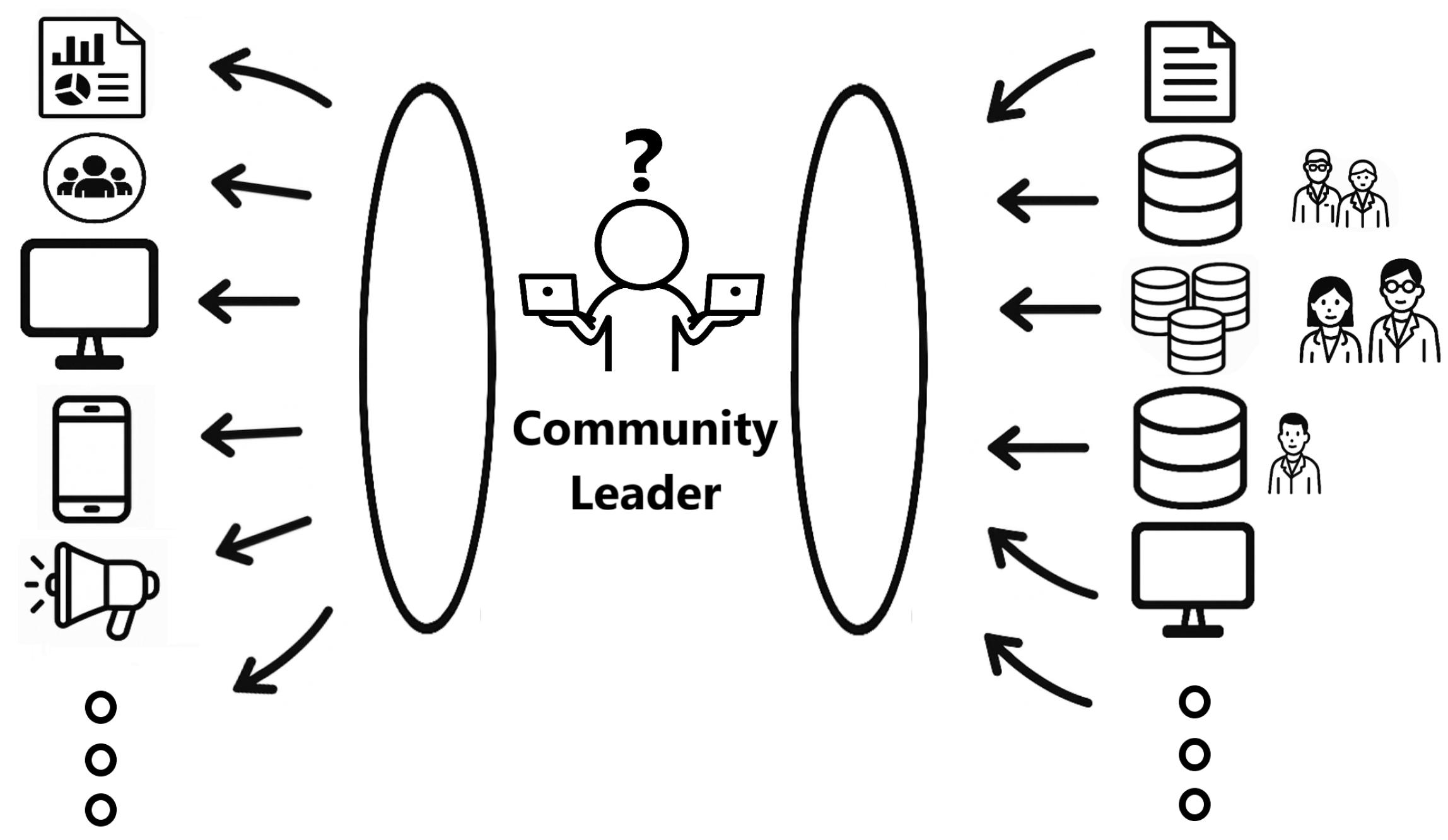
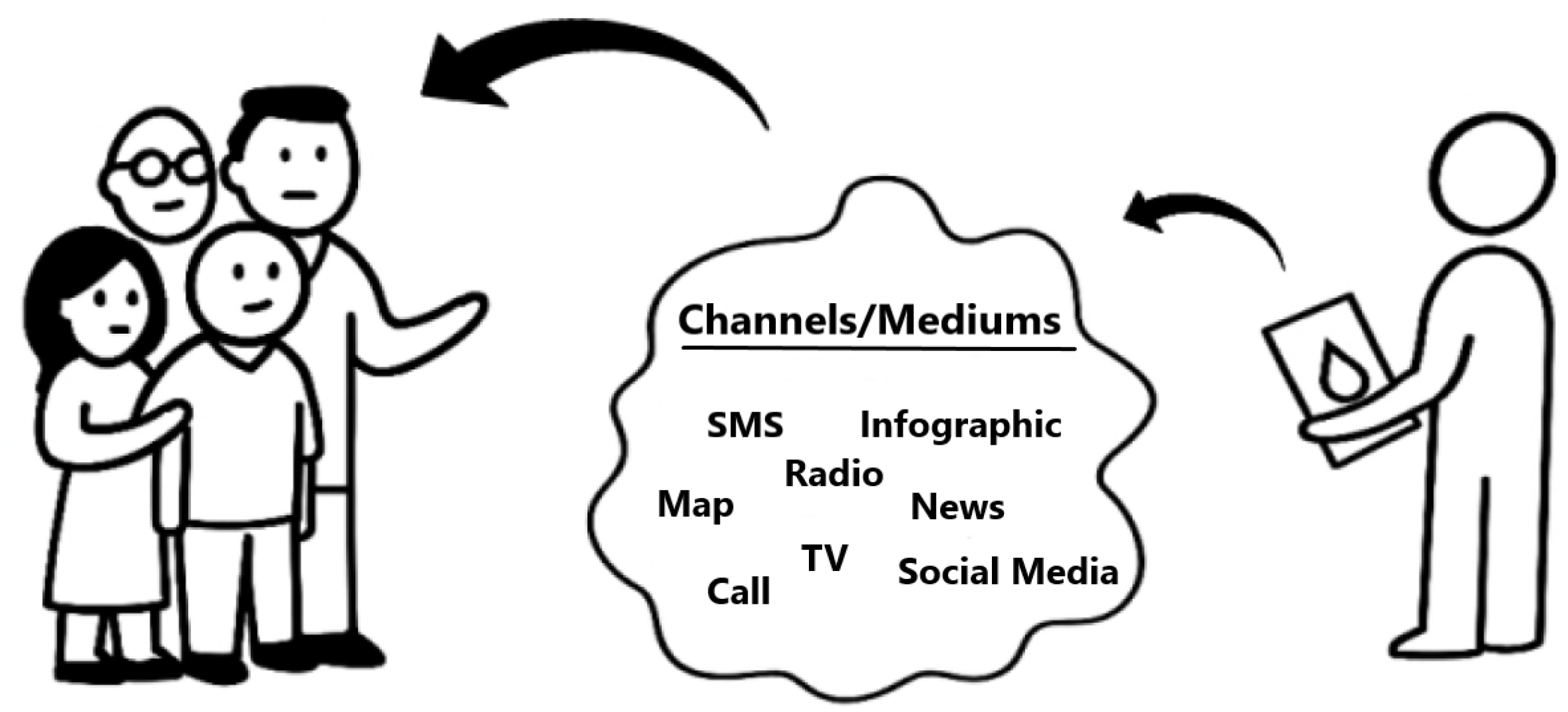
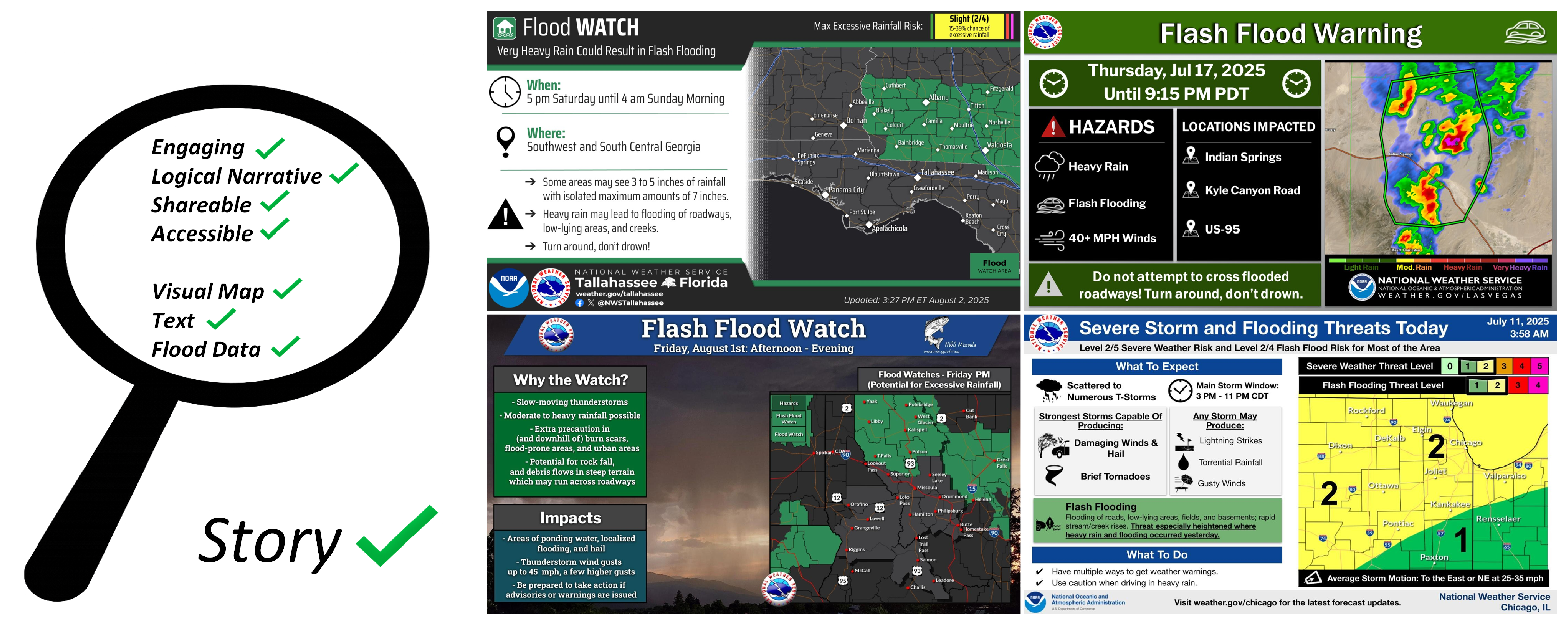


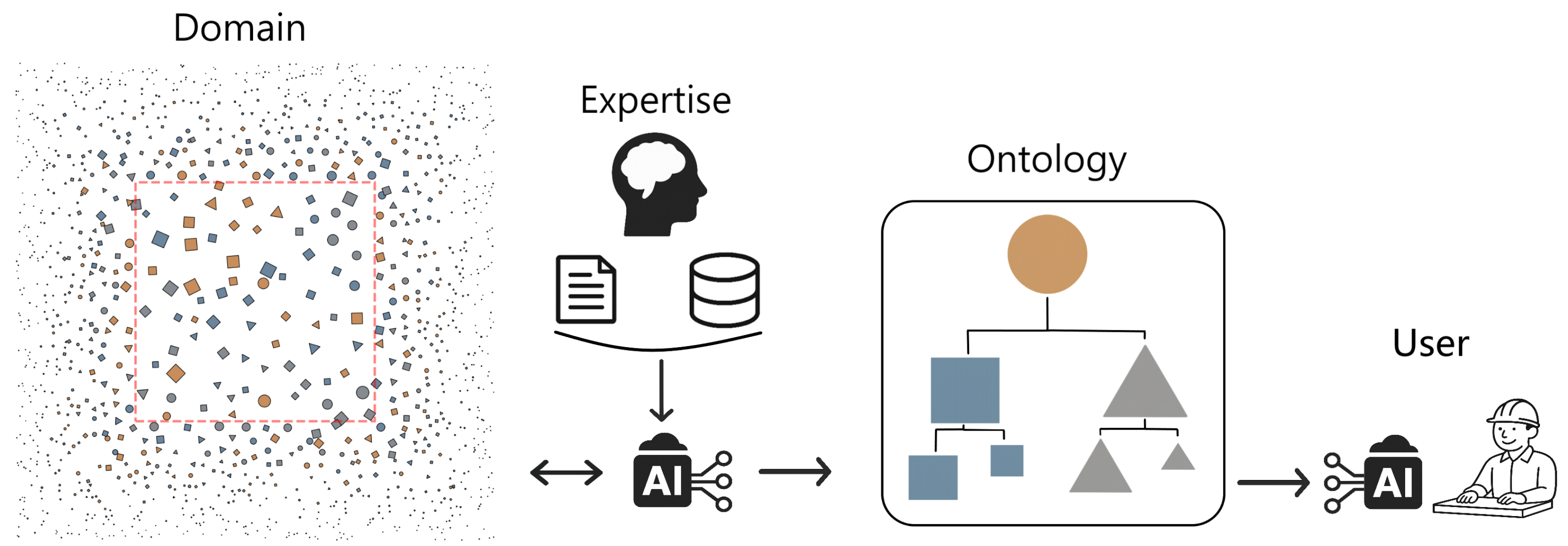
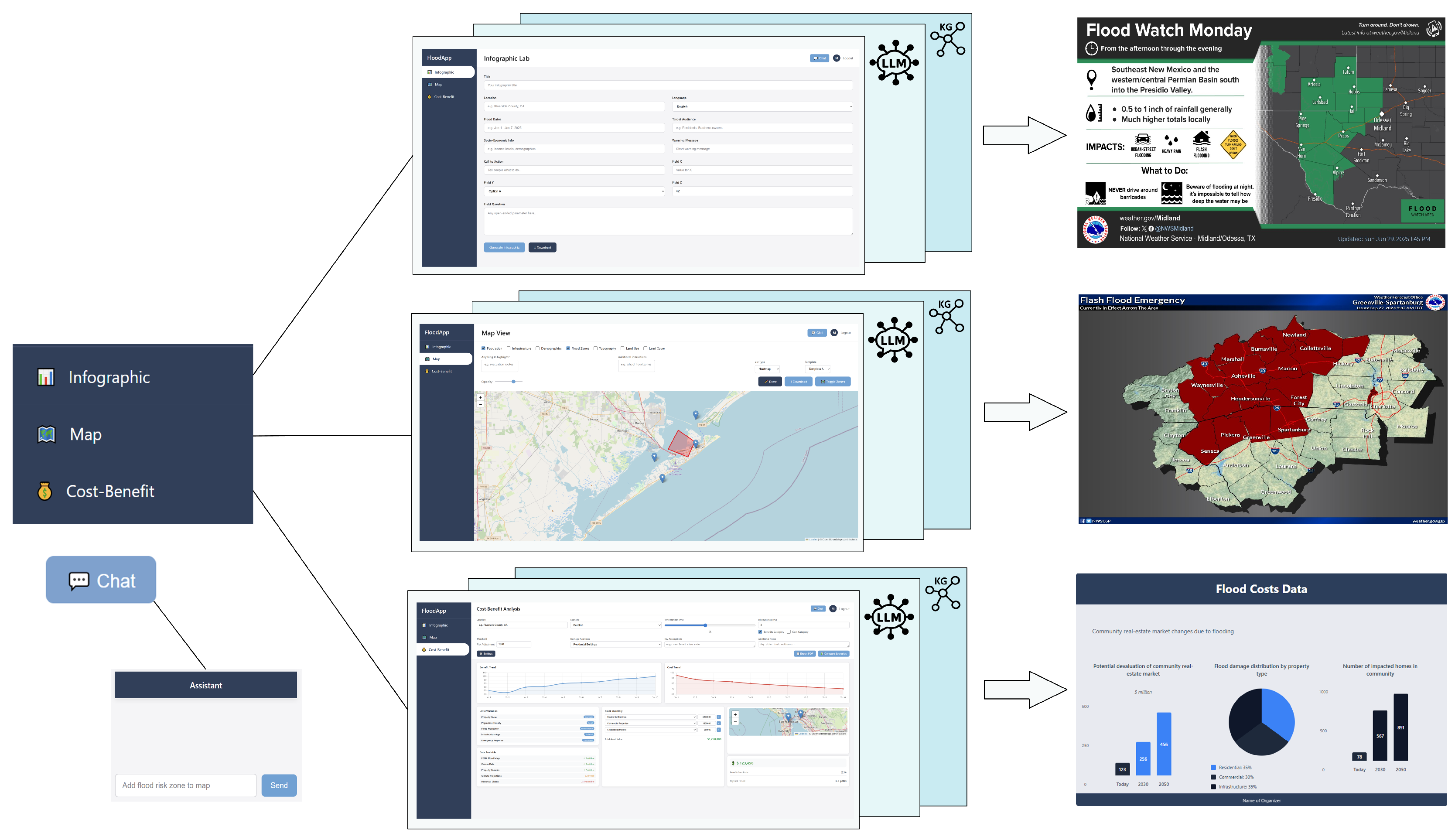
| Communication Channels | Text | Images | Video | Audio | Real-Time Information | Interactive |
|---|---|---|---|---|---|---|
| Social media platforms | X | X | X | X | X | X |
| YouTube | X | X | X | X | X | X |
| Mobile apps | X | X | X | X | X | X |
| Webinars | X | X | X | X | X | X |
| News websites | X | X | X | X | X | – |
| Government websites | X | X | X | X | X | – |
| Public service announcements | X | – | X | X | X | X |
| Television | X | X | X | X | X | – |
| Blogs | X | X | X | X | – | – |
| Online forums | X | X | – | – | – | X |
| Emergency alert systems | X | – | – | X | X | – |
| Community bulletin boards | X | X | – | – | – | X |
| Radio | – | – | – | X | X | – |
| Newspapers | X | X | – | – | – | – |
| Magazines | X | X | – | – | – | – |
| Email newsletters | X | X | – | – | – | – |
| Text alerts (SMS) | X | – | – | – | X | – |
| Podcasts | – | – | – | X | – | – |
| Word of mouth | – | – | – | – | X | – |
| Press releases | X | – | – | – | – | – |
| Tool Name | Cost Benefit | Communication | Map Visualization | Free | Global Scale | Infographic and Story Gen. |
|---|---|---|---|---|---|---|
| FloodBrain | – | – | X | X | X | – |
| FloodWaive | – | – | X | – | – | – |
| Google Flood Hub | – | – | X | X | X | – |
| HydroSphereAI (Aquanty) | – | – | X | – | X | – |
| Okeanos (Netilion Flood Monitoring) | – | X | X | – | – | – |
| Jacobs Flood Platform | – | – | X | – | X | – |
| Floodbase | – | – | X | – | X | – |
| One Concern | X | – | X | – | X | – |
| Jupiter Intelligence | X | – | X | – | X | – |
| Stantec Flood Predictor | – | – | X | – | X | – |
| Vassar Labs’ Flood Tool | X | X | X | – | X | – |
| MIT’s AI for Satellite Images | – | – | X | X | X | – |
| AECOM’s Flood Risk Mapping | – | – | X | – | – | – |
| Esri’s Flood Modeling Tools | – | X | X | – | X | – |
| Risk Factor (First Street) | – | – | X | X | – | – |
| Iowa Flood Center AI | – | X | X | X | – | – |
| Texas A&M Flood Tool | – | – | X | – | – | – |
| FLAI | X | X | X | X | X | X |
Disclaimer/Publisher’s Note: The statements, opinions and data contained in all publications are solely those of the individual author(s) and contributor(s) and not of MDPI and/or the editor(s). MDPI and/or the editor(s) disclaim responsibility for any injury to people or property resulting from any ideas, methods, instructions or products referred to in the content. |
© 2025 by the authors. Licensee MDPI, Basel, Switzerland. This article is an open access article distributed under the terms and conditions of the Creative Commons Attribution (CC BY) license (https://creativecommons.org/licenses/by/4.0/).
Share and Cite
Zajac, M.; Kulawiak, C.; Li, S.; Erickson, C.; Hubbell, N.; Gong, J. Unifying Flood-Risk Communication: Empowering Community Leaders Through AI-Enhanced, Contextualized Storytelling. Hydrology 2025, 12, 204. https://doi.org/10.3390/hydrology12080204
Zajac M, Kulawiak C, Li S, Erickson C, Hubbell N, Gong J. Unifying Flood-Risk Communication: Empowering Community Leaders Through AI-Enhanced, Contextualized Storytelling. Hydrology. 2025; 12(8):204. https://doi.org/10.3390/hydrology12080204
Chicago/Turabian StyleZajac, Michal, Connor Kulawiak, Shenglin Li, Caleb Erickson, Nathan Hubbell, and Jiaqi Gong. 2025. "Unifying Flood-Risk Communication: Empowering Community Leaders Through AI-Enhanced, Contextualized Storytelling" Hydrology 12, no. 8: 204. https://doi.org/10.3390/hydrology12080204
APA StyleZajac, M., Kulawiak, C., Li, S., Erickson, C., Hubbell, N., & Gong, J. (2025). Unifying Flood-Risk Communication: Empowering Community Leaders Through AI-Enhanced, Contextualized Storytelling. Hydrology, 12(8), 204. https://doi.org/10.3390/hydrology12080204






